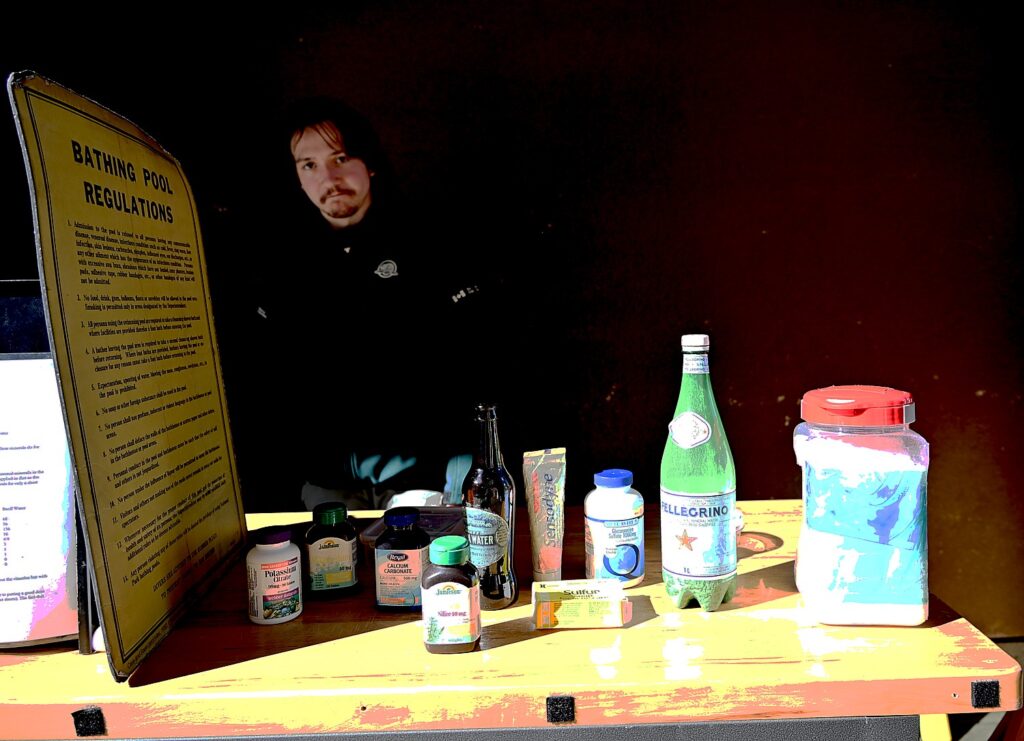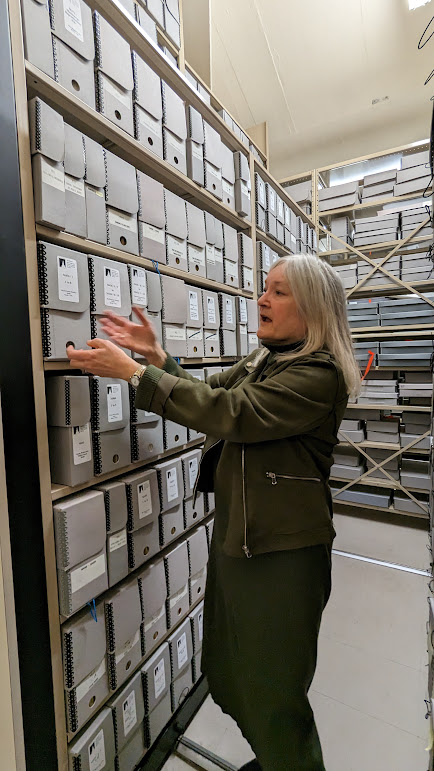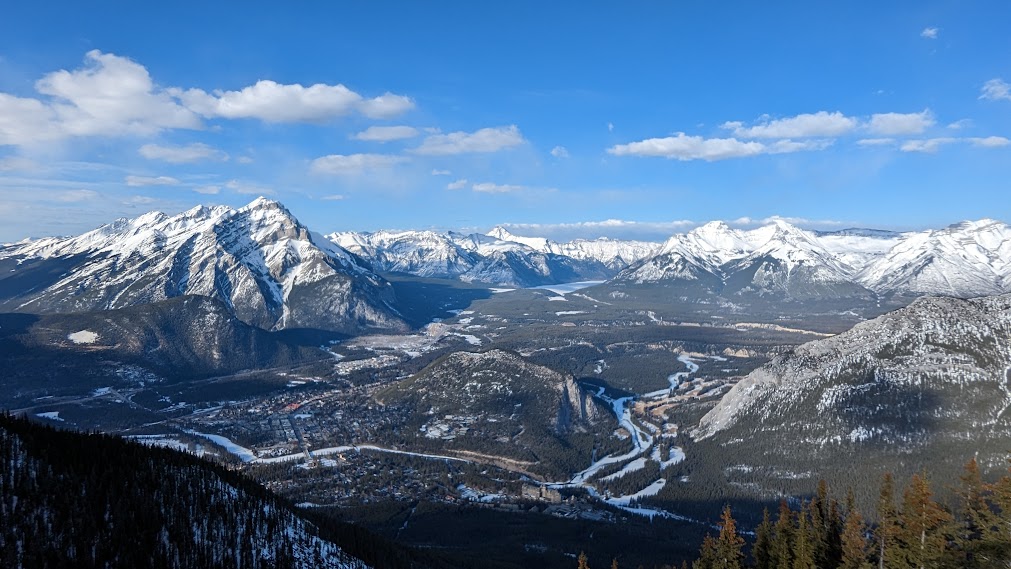
By Karen Rubin, Travel Features Syndicate, goingplacesfarandnear.com
The spirits of the founders, pioneers and entrepreneurs are everywhere in Banff, which, for a small town within an immense national park (Canada’s most visited) continue to inspire the 4.5 million who come each year with their rich heritage, cultural legacy, and heady exhilaration of the Rocky Mountains.
We find their presence ever-present – at the Mount Royal Hotel, one of the oldest in Banff; at the Cave & Basin historic site (the hot springs that started it all); at the Whyte Museum and the Moore House; at a museum that tells the story of Banff National Park (Canada’s first national park and one of the oldest in the world); atop the Banff Gondola, the old Trading Post (which I remember visiting decades ago), the Open-Top Sightseeing tour in custom-designed vintage automobile, and most spectacularly, the Buffalo Nations Luxton Museum.
I love that all around the Sky Bistro on the summit of Sulphur Mountain are poster-sized photos of Banff’s pioneers and founders, many who are already familiar from our Open-Top sightseeing tour, the Whyte Museum, and the historic markers about town: There are the Brewster brothers, Norman Luxton, and the colorful park warden, Bill Peyto, who toted a live lynx into a bar. There are the indomitable, liberated women like Pearl Brewster, who manifested the frontier, mountaineering spirit; Caroline Hinman, who came from New Jersey to organize Off the Beaten Track pack trips; and Lizzie Rummel, who, born to a German aristocratic family, came to the Rockies in 1914 and ran back country lodges.

Cave and Basin
The visit to Cave and Basin is like going back to the origin story for Banff – it is the very reason Banff developed and why Canada’s first national park was established here, though this area had been a special place for First Nations peoples for 10,000 years. Modern Banff was born here, at Cave & Basin historic site.
“… like some fantastic dream from a tale of the Arabian Nights,” is how William McCardell described the mist-filled cave on the slopes of Sulphur Mountain when he, his brother Tom, and their partner Frank McCabe, three railway workers who stayed behind, first spotted the venting steam in the fall of 1883.
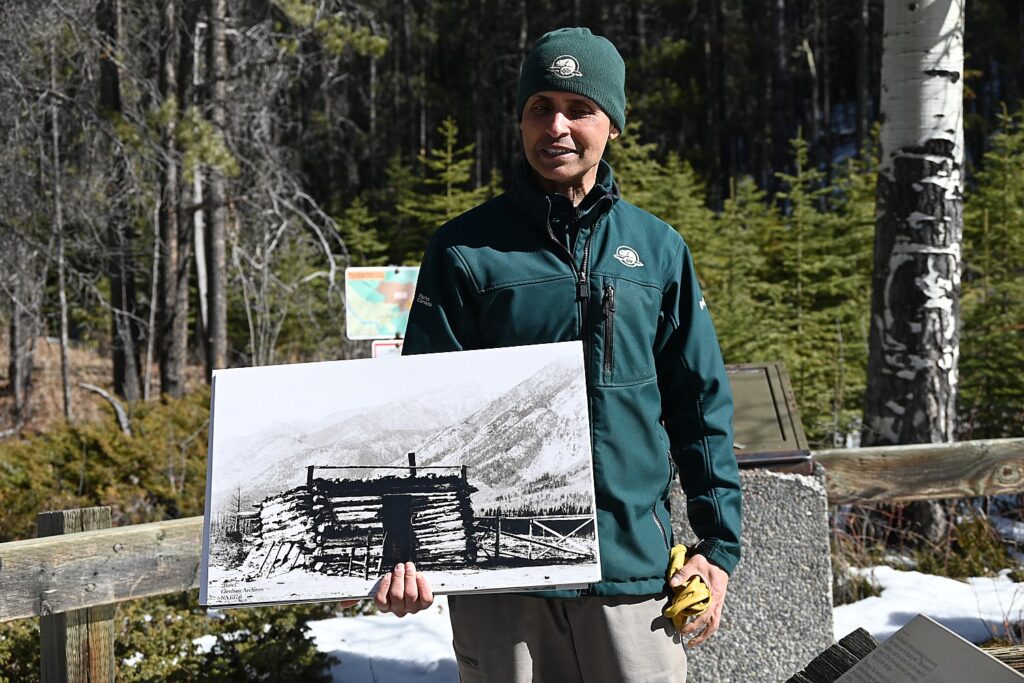
They immediately saw the profit potential, fenced it off, built a small log cabin at the entrance (they called it “the hotel”) and put in a claim for a land grant. But the Canadian government, in financial straits from building the transcontinental railroad, also saw the potential (the popularity of thermal springs in Arkansas and Yellowstone was already known). The government paid them off with $900 and, in 1885, set aside 10 square miles around the thermal springs. In 1887, Prime Minister John A. McDonald declared the land protected for all Canadians and named George Stewart, park superintendent.
Canadian Pacific’s visionary executive director, William Cornelius Van Horne, built and opened the Banff Springs Hotel in 1888 with 250 rooms, and invited writers and artists to come to promote the destination.
At the Cave and Basin (the cave has an interior thermal pool and the basin has an outdoor thermal pool), people paid 5c to enjoy bathing, one sex at a time – ladies in the cave when men were in the basin, and visa versa.
A 30-minute guided tour takes us into the cave (surprisingly small) and the basin (where we get to see the tiny, endangered Banff Springs snail that only exists here), and tour the 1914 Bathing Pavilion.
Our guide, Ranger Amar Athwal, tells us that 500 generations of indigenous people gathered here at the hot springs before the first Europeans ever arrived; one of the oldest artifacts found in the area is a bison skull from 8500 years ago, bearing wounds inflicted by humans.
The Europeans first came in a quest to find a route to Asia and then to trap beaver (nearly to extinction, before silkworms were used to make hats). And then the transcontinental railroad came through, to unite the fledgling country.
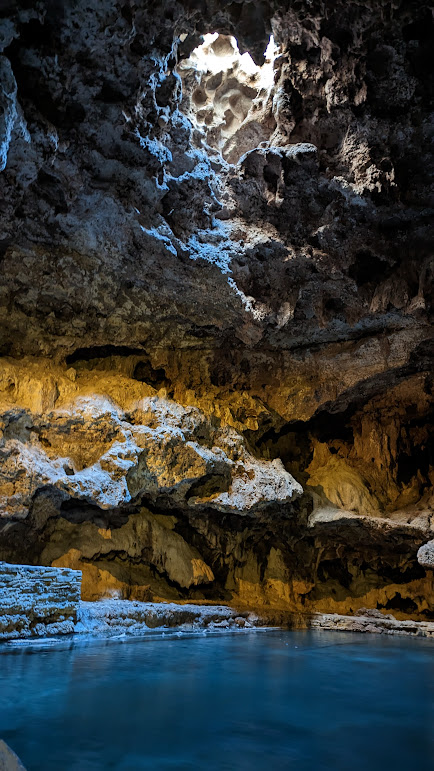
The natural springs, mysteriously hot even in winter and supporting plants and life that did not exist anywhere else, were regarded as a spiritual place of healing, and where different tribes gathered to hold ceremonies in peace here. (When the park was created, the native communities were pushed out.)
The natural springs are a unique ecosystem, Athwal tells us. The water flows year-round despite the fact that temps can go as low as minus 41 degrees in winter in Banff. Here, the water stays 92-100 F so plants grow here, animals like the garter snake live here, and the Basin harbors a tiny snail that is unique to these Banff thermal springs (which we get to see).

The smell comes from the bacteria that takes in the sulphur particles and gives off gas – in high concentrations, it would be fatal. The waters smell differently, even within this place, depending upon what chemicals the bacteria is feeding on.
The waters were regarded as healing by the indigenous peoples as well as the settlers – entrepreneurs would sell bottles of the water, like snake oil.
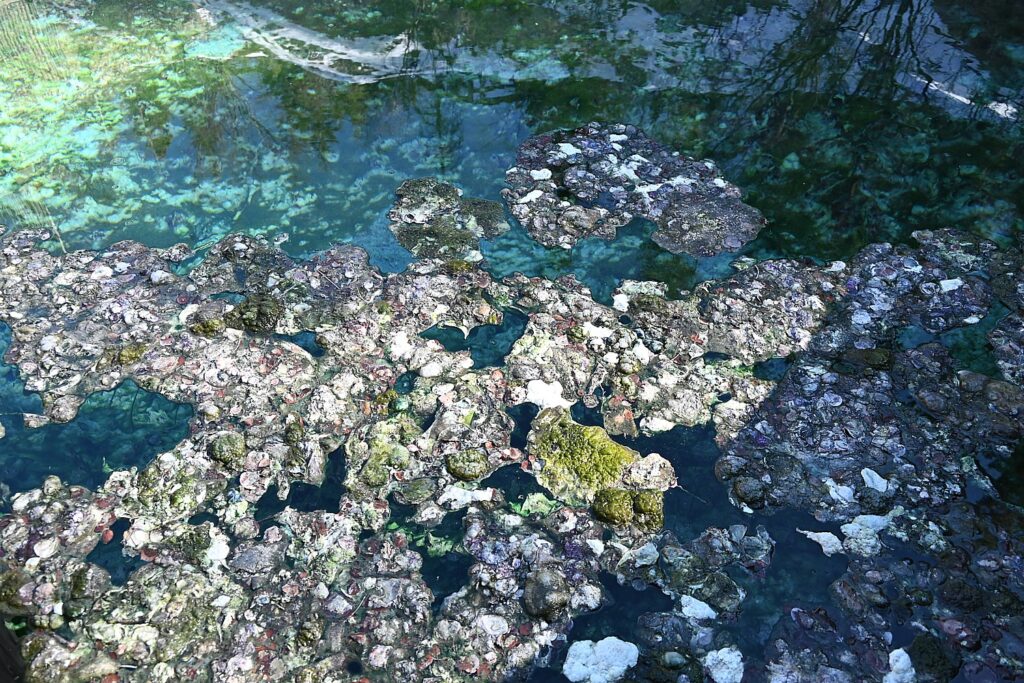
Germans, Austrians, Hungarians and Ukrainians who were recruited as mountain guides and to build the railway with a promise of land, were interred here when World War I broke out, fearing “enemies within,” from 1914 to 1920. They were used as labor and built this gorgeous bath house and outdoor pool. Only recently did Canada issue an official apology and provide funding to create a memorial exhibit here, which opened in 2013.
You can also stroll the thermal water boardwalks (the best bird watching in Banff National Park) and hike trails around the Cave and Basin (https://parks.canada.ca/lhn-nhs/ab/caveandbasin).
Whyte Museum
The Whyte Museum of the Canadian Rockies is a historical museum, art gallery, and archives that celebrates the lively history, heritage and people of the Rocky Mountains.
The museum was founded in 1968 by Peter and Catherine Whyte who were artists and philanthropists. Peter Whyte’s father, Dave, came out with the railroad and started a grocery store. Peter grew up here and built a compound with their home and other cabins.
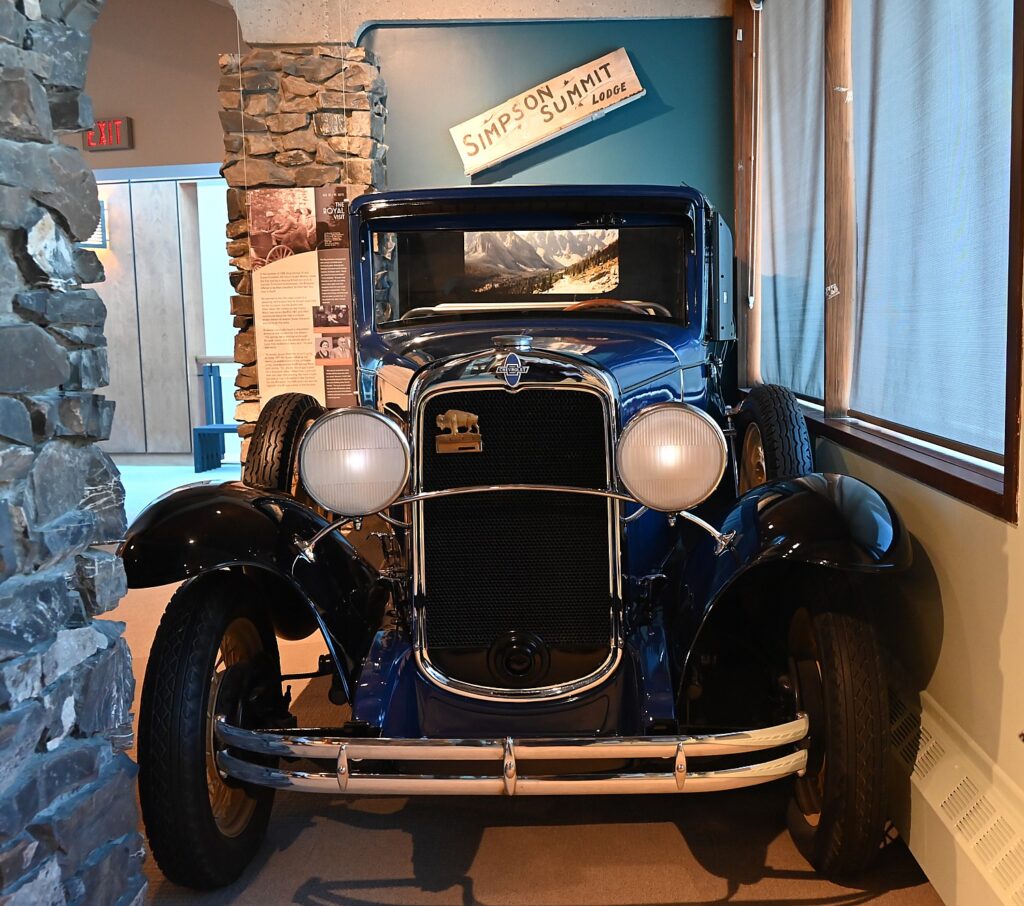
The Whyte Museum offers four galleries, including a heritage Gallery. It is a marvelous display, where we see an actual open-top vehicle the Brewsters designed, fantastic photos (including them driving the King and Queen of England in 1939), so that you feel you are literally walking through history.
But my favorite part of visiting the Whyte Museum is the visit to the Moore House, which is on the museum’s property.

The cottage belonged to Pearl Brewster Moore, who was Jim and Tom Brewster’s sister (born 1889, she was the only girl among seven children). The cottage dates from 1907 when she married Philip Moore, a Princeton graduate from New Jersey who came to Banff as a guide), and contains the couple’s own furnishings, so is a window into their lives and the times – their sheet music on the piano, their books, a stunning Chippendale dining set from Philip’s New Jersey family.
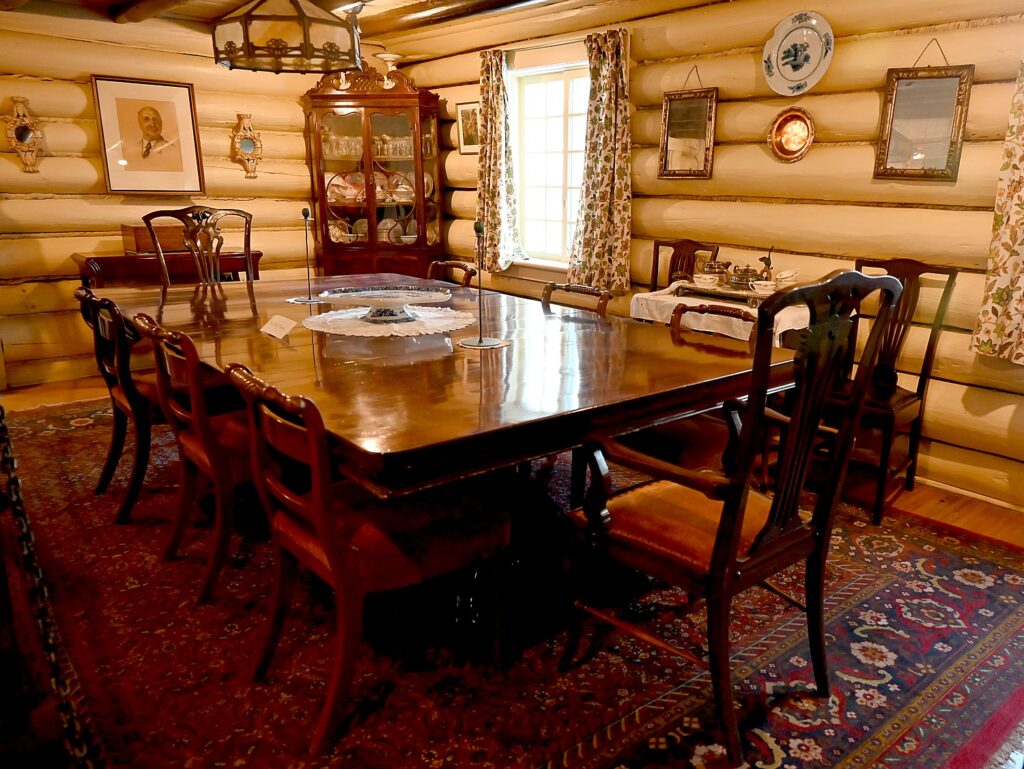
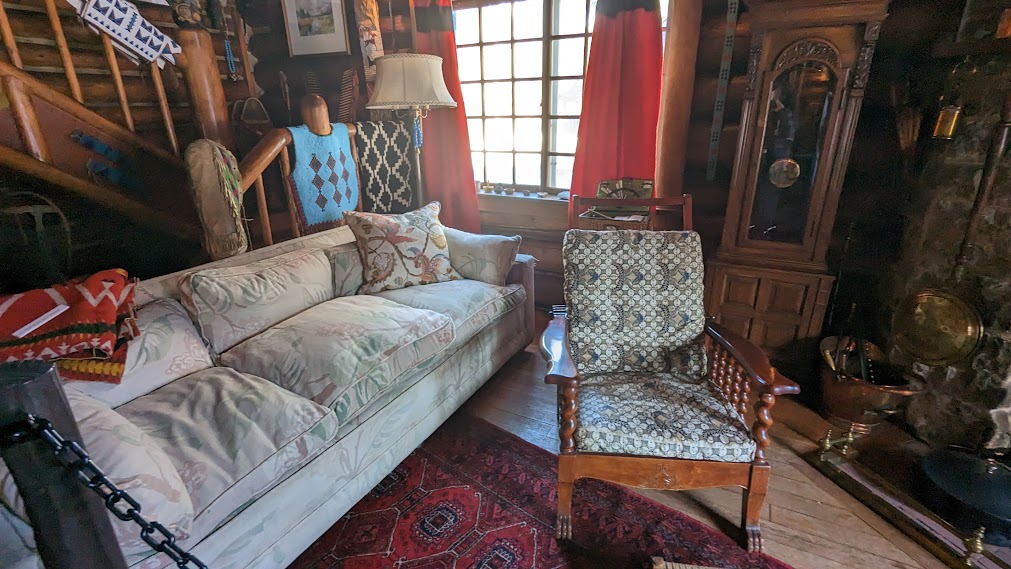
“She had 6 brothers – that shaped who she was: a horsewoman, she hunted, played hockey,” our guide tells us. “Pearl led trail rides. Her parents sent her to two finishing schools – she was sent home from both. When Pearl passed away in 1973, the obituary called her ‘one of the best horsewomen,’ and she was remembered for her forthright opinions she was not afraid to express.”
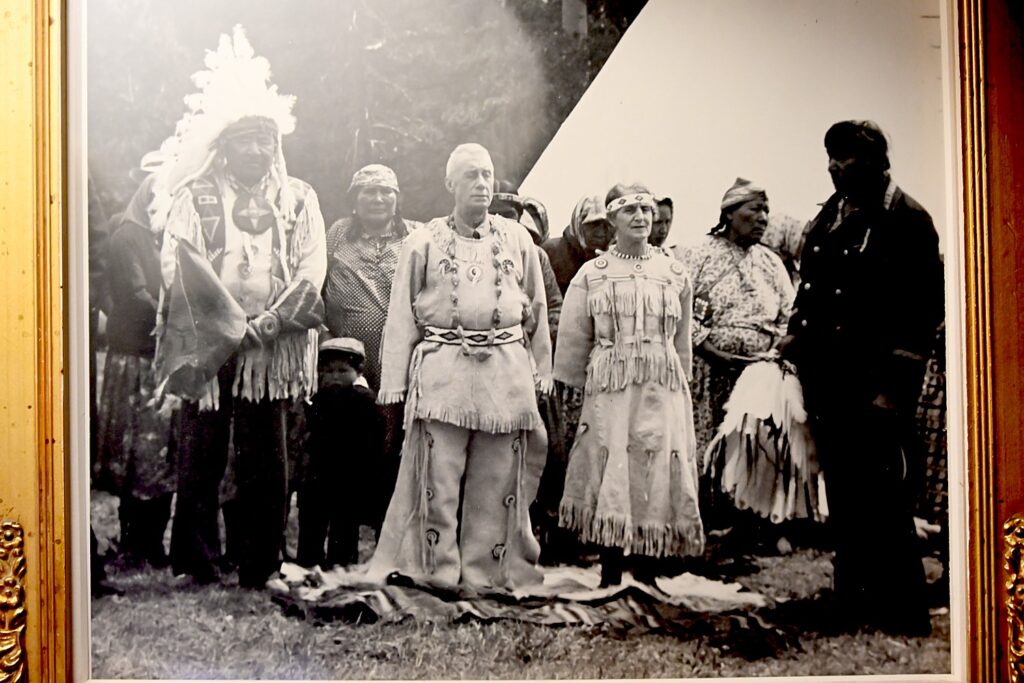
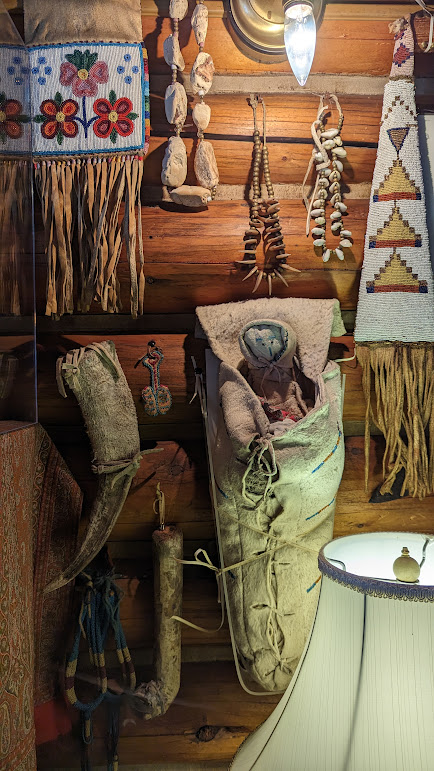
You get to see the Moores’ many indigenous artifacts. The couple had close ties with the Stoney Nakota and were made honorary members of the tribe. Pearl regularly judged their beadwork competitions. And I note a book on Indian sign language in the book case (Philip majored in history and English at Princeton).
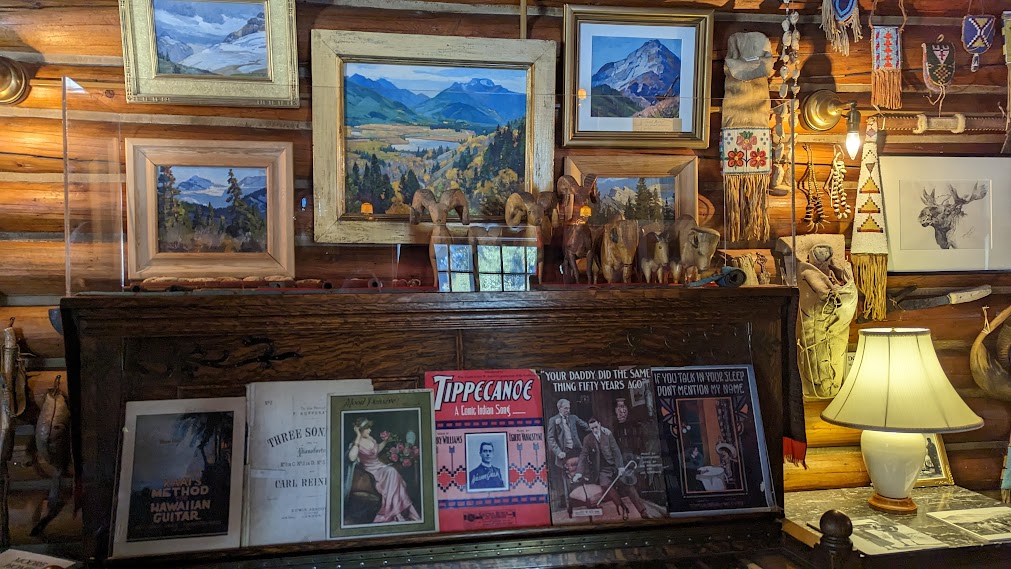
They had one child, Edmee, born 1908, who sadly pre-deceased Pearl. Her husband, Philip died in 1971. That same year, Pearl bequeathed the house and contents to the Whyte Museum and had it moved from its original location on Fox Street (there is a hotel there now) to the Whyte Museum grounds where she lived until her death just two years later, in 1973.
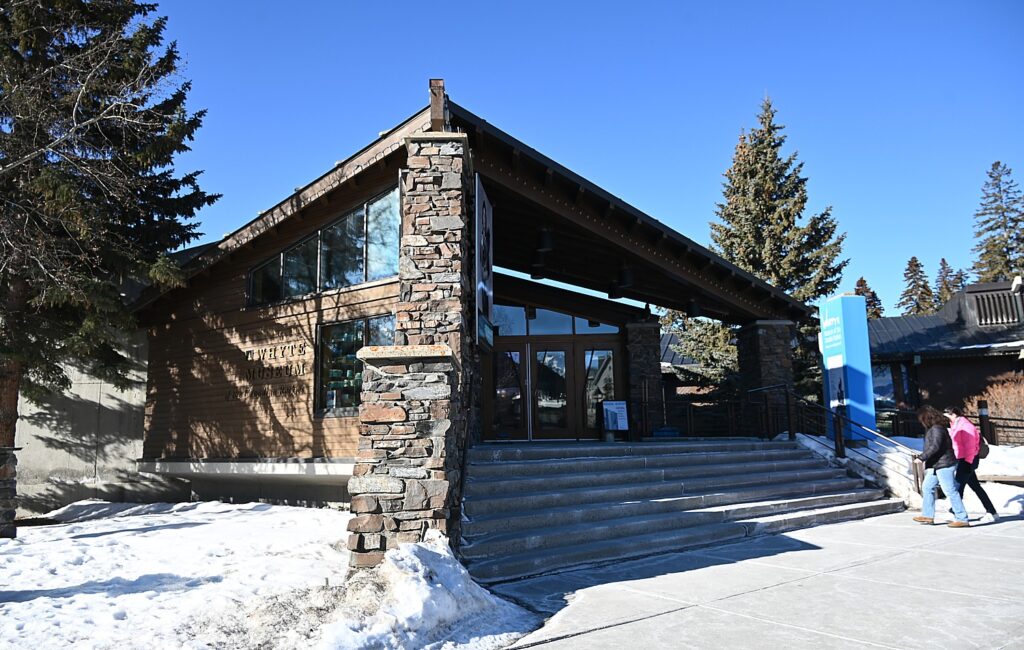
The Whyte Museum also houses important archives, especially of mountaineering (it holds the Alpine Club of Canada’s archive that spans 50 meters of shelves), the Banff National Park history, Crag & Canyon newspapers (Norman Luxton’s newspaper) going back to 1900. You can actually consult the card catalog with typed entries (who remembers those?), as well as digital catalogs (www.whyte.org).
We pick up sandwiches from the café at the Elk & Avenue hotel, and set out to picnic at Lake Minnewanka (the name means “Spirit Water”). There is still snow and the lake is still frozen enough for us to walk on (someone has started to build an igloo and another couple is posing for wedding photos). It is a delightful place that is especially popular in summer – hiking trails, boating and scenic cruises from the marina (also operated by Pursuit Collection which has the snack shop).
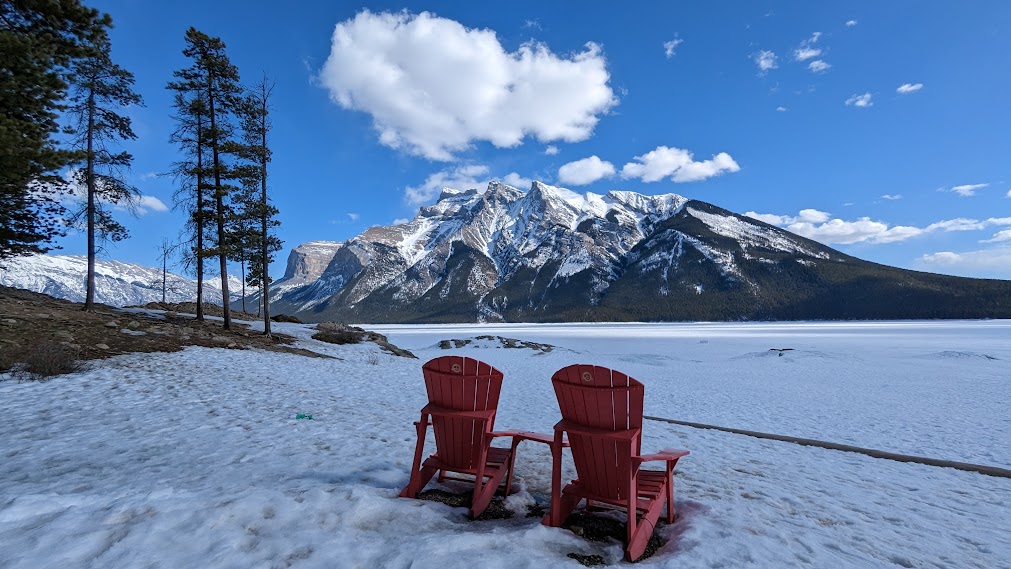
Blackfoot Nations Luxton Museum
I go off on my own to explore, and come to the Blackfoot Nations Luxton Museum, next to the Trading Post which Luxton started.
Visiting the Blackfoot Nation Luxton Museum fills in that 10,000-year gap before the railroad workers discovered the hot springs.

This is an astonishingly excellent museum that takes a bit of patience and focus to really appreciate. But once you spend a little time, you are overwhelmed by what is on view. It has the feeling of visiting a private collection (it was the collection of Norman Luxton), even with a comfy sofa where you can sit to watch a series of fascinating videos.
There is a feeling of informality and personal engagement. The notes that are provided actually give a more direct and different perspective than other indigenous museums I have visited.
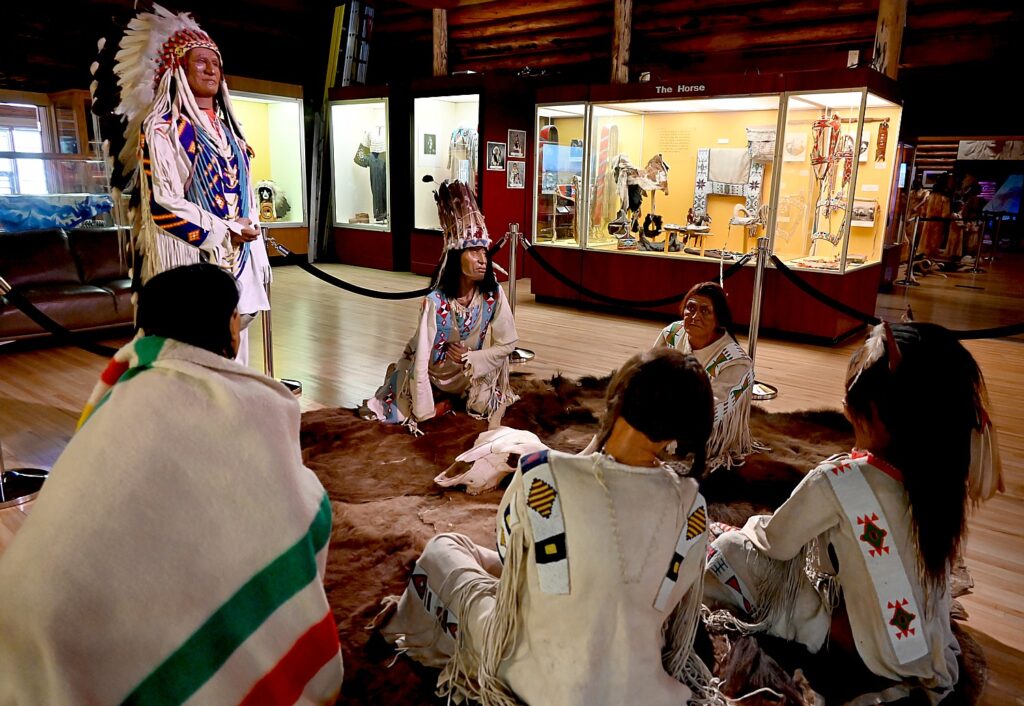
You see realistic manikins in indigenous dress, surrounded by artifacts in settings staged to put you in the scene –a meeting in a teepee, a gathering around a fire.
There are fabulous historic photographs often placed adjacent to the artifact. So right beside a beaded leather baby carrier is a black-and-white photo of a woman with that carrier (with baby) on her back.

You learn that horses, introduced in the 1700s “gave more time for war, religion, craftsmanship….[because they] saved time for hunting, traveling” (and probably was like a major new weapon for battle, like a tank, changing the battlefield.)
I sit myself in a comfortable sofa and watch a video about the residential schools that First Nations children were forced away from their family to attend, and a group’s activism to recover the heritage that had been stolen from them. It takes you into the vacant, dilapidated building, like a prison, that would have been their residential school.
“Their idea was to kill the Indian in the man, but both were killed…Treaties broken over and over – not just money, but trust,” that narrator says. “The schools were like jail. You would be punished if you couldn’t find a shoe. You became Christian for survival…the biggest defiance is who I am now.”
Several tribes – the Nahota, Blackfoot and Cree – and the Wildlife Conservation Society are featured in the video signing a Repatriation Treaty to bring back the buffalo.
The museum feels personal because it is founded on the personal collection of Norman Luxton, one of Banff’s pioneering founders, who, the more I learn about him, the more I admire him. He seems to have been a mix of P.T. Barnum, Wild Bill Hickok, William Hearst, and Thor Heyerdahl, and I can’t get enough of his story, especially as I explore Banff.

I love this man. When he was in his 20s, he sailed around the world in a 100-year old, 30-foot long dugout canoe with an eccentric sea captain, going as far as Tahiti, Samoa and Fiji. He was a newspaper man who took over and saved the Crag & Canyon, still published today, built Banff’s first all-season hotel, filling it with the latest technology (gramophone!); opened its first cinema (one of first to screen talkies and Technicolor, still operating today).
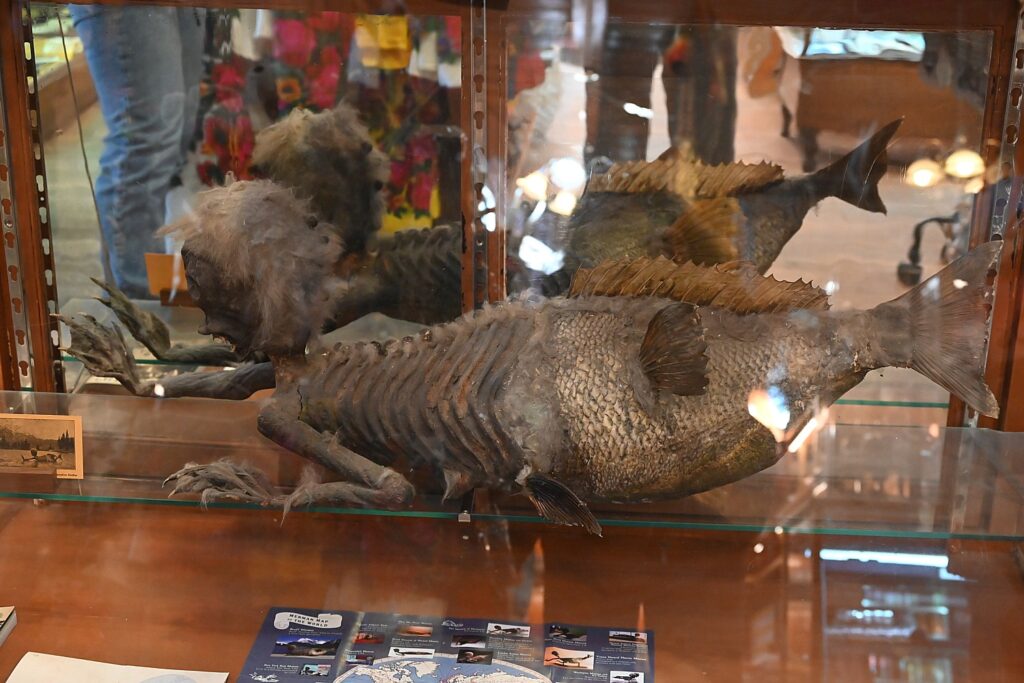
Luxton promoted trade and economic development of the Indigenous peoples, opening the Trading Post (a combination curio shop featuring indigenous crafts and taxidermy shop), promoting it with a bear (“Teddy”) that tourists were encouraged to feed chocolate they purchased at the shop and, P.T. Barnum-like with a “Fiji Merman”.
Luxton, who earned the nickname, “Mr. Banff” for all he did to develop and promote Banff, began the Winter Carnival events in 1917 that helped turn Banff into a snow-sports destination and from 1909-1950, organized the Banff Indian Days, an annual weekend event that brought locals, tourists and First Nations peoples together. And finally, he turned his amazing collection of First Nations artifacts into a museum. (https://banff.ca/1135/Norman-K-Luxton)
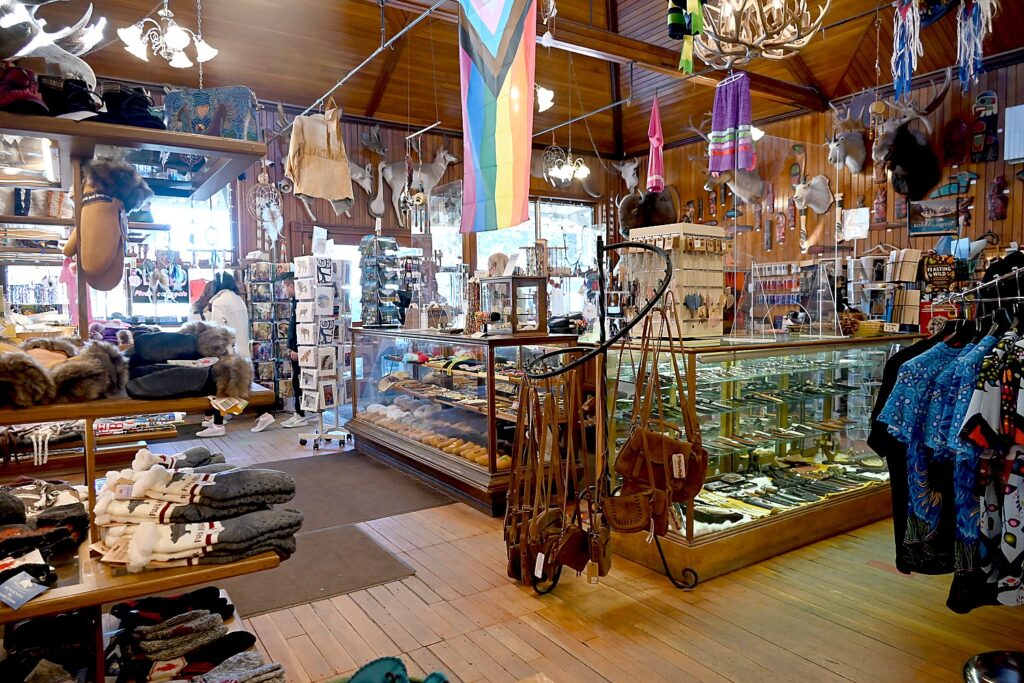
Throughout his life, going back to when he was 21 and delivering treaty payments to tribes, Luxton displayed his respect for the indigenous people, and not only helped save their heritage, their culture but provided a proper platform and visibility, when indigenous art and culture was made illegal, invisible, with a goal of eradicating the culture – and the people – altogether.
The Luxton Museum of the Plains Indian opened in June 1953, now the Buffalo Nations Museum. Built of logs to resemble a Hudson’s Bay Trading Post, the museum allowed Luxton “to share and preserve his extensive collection of Indigenous artifacts and cultural items, providing a better understanding of and appreciation for local First Nations peoples and cultures for locals and visitors alike.” (see www.luxtonfoundation.org).
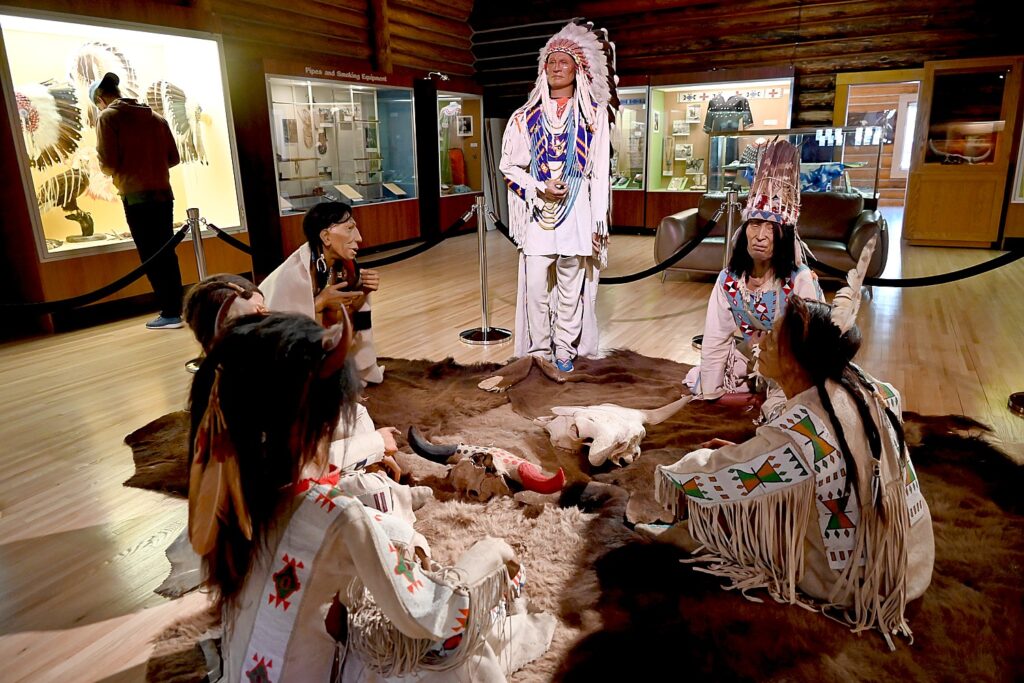
“The Buffalo Nations Luxton Museum is dedicated to the appreciation, interpretation, demonstration and display of the cultures, traditions, and values of the First Nations of North America and their trading partners. The museum seeks to show how the people of this land lived and adapted to their surroundings and each other prior to contact with European culture, and how they continued to adapt after European influences.” (https://www.buffalonationsmuseum.com/content/museum).
A Town That Cherishes its History
Befitting a town built on tourism, they really know how to cater to visitors – there are wonderful signs, markers, historic plaques (there are 48) and descriptions (there are 179 sites listed on its Inventory of Historic Resources including 25 Landmarks and Legends, which can be accessed on its Heritage Finder website, https://banff.ca/113/History-and-Heritage ) that immerse you in their stories.
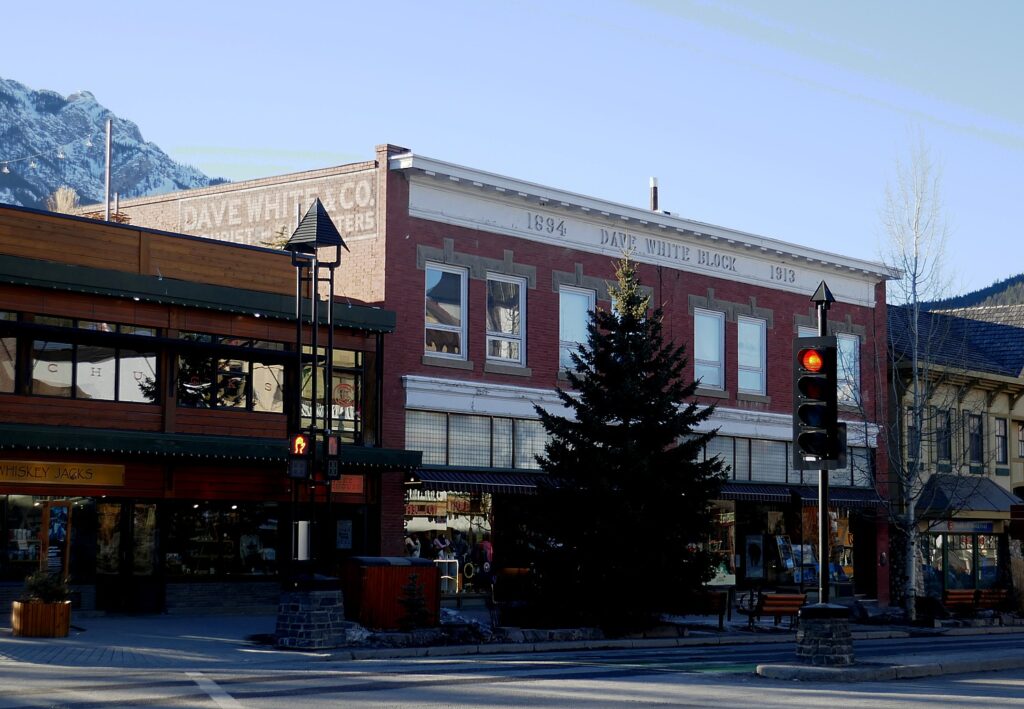
One of Banff Avenue’s first merchants was David White who arrived in Banff in 1885 and became a railway section foreman. He stayed on and in 1894 opened a general store on this site. In 1908, a brick building replaced the “boomtown’ Park Store. Renovated in 1996, the Dave White Block is the oldest remaining commercial building on Banff Avenue.
There is a Hudson Bay Company store that is only now closing (incorporated 1670, and responsible for European settlement of these western territories).
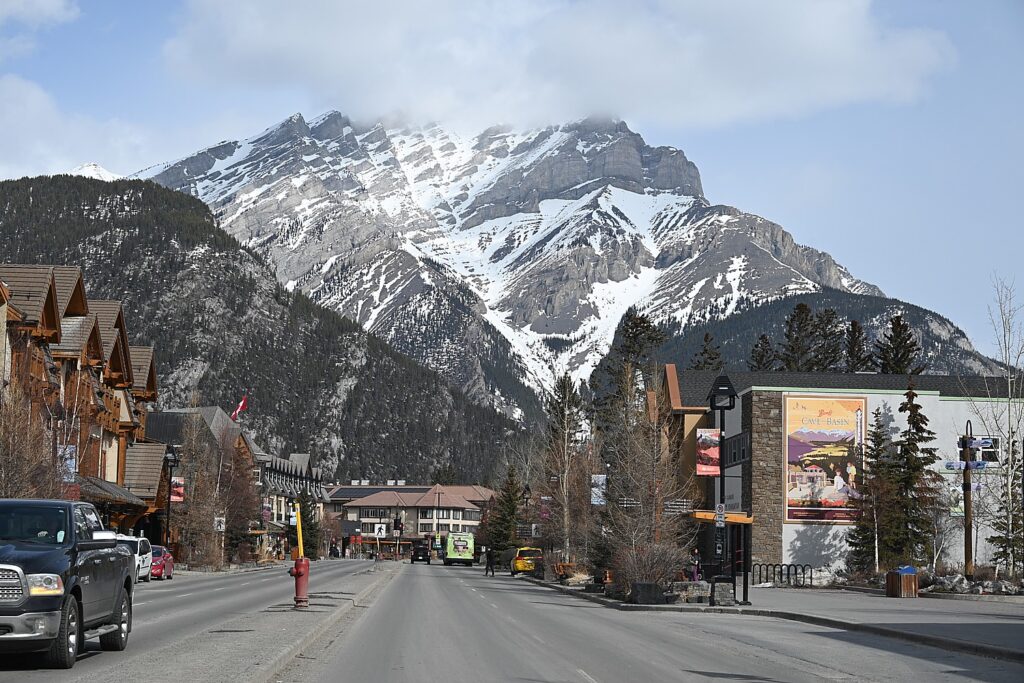
I stop at a marker in front of the Elk Lodge, which I learn began “life” as The Browne Residence in 1921, the home of American hunter and wildlife artist Belmore Browne born 1880 in New York City. In 1912, he accompanied one of the first parties to attempt Mt. Mckinley in Alaska and came within 125 feet of the summit, a North American climbing record. Browne arrived in Banff in 1921 and purchased a single room log cabin on this site, later adding an artist’s studio. It served as a summer studio and home from 1921 to 1946, from which he painted many of the illustrations for the Canadian Pacific Railway literature, in exchange for transport to the east coast. Margaret Aldhelm White purchased the property in 1947, added and transformed it into the Elkhorn Lodge, one of Banff’s oldest guest lodges still operating today. “This Lodge is a good example of the adaptation and reuse of older buildings.”
In fact, The Town of Banff was only incorporated as a municipality in 1990 – the first municipality in Canada to be incorporated inside a national park. (The only other national park community in Canada is the Municipality of Jasper, in Jasper National Park, incorporated in 2001.)
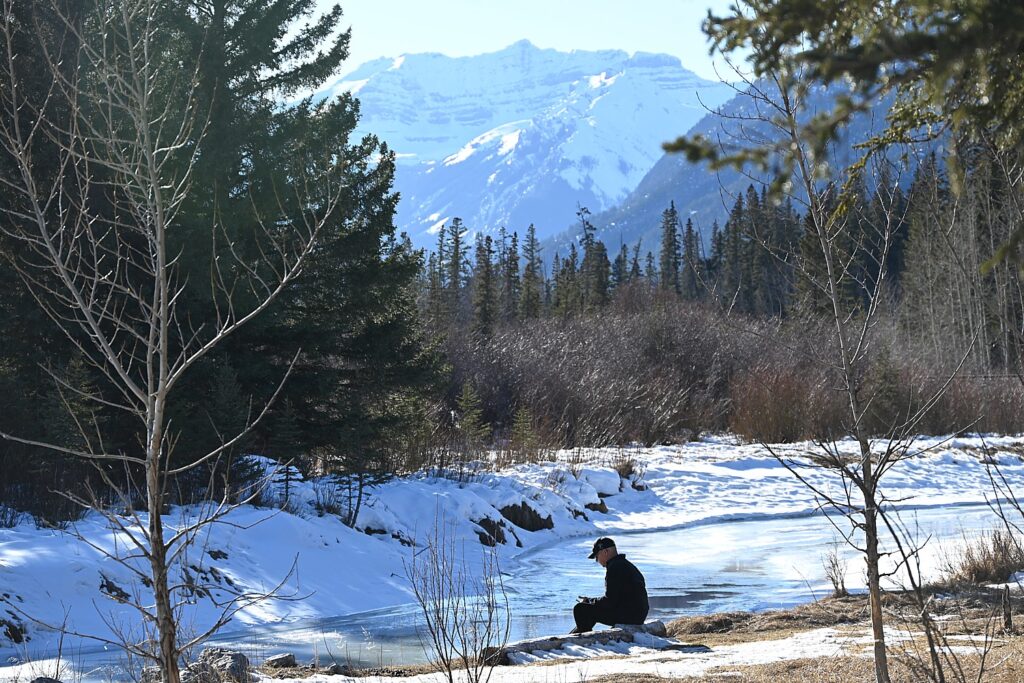
I delight in wandering Banff, which though very compact and walkable, has all these marvelous trails and paths – my favorite on both sides following the river (actual hiking trails were still too icy during our visit), and bring you to the Bow Falls.
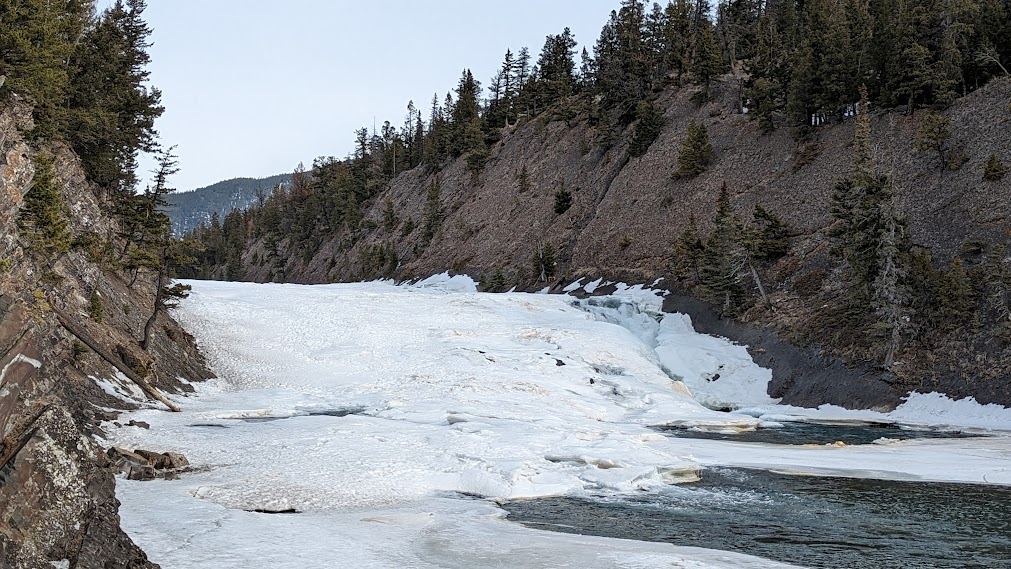
People came out here, settled here to be adventurous, to test their mettle climbing mountains, riding horses, hunting, to be free of the constraints of urban “civilized” society. So many of the pioneers and founders and entrepreneurs we encounter – women included – came from New York, New Jersey, and Europe. Visitors today – the 4.5 million who come to Banff National Park in a year – seek the same sense of adventure.
You can find Pursuit Collection’s services and attractions at https://www.pursuitcollection.com/; to book Pursuit Collection’s Banff and Jasper experiences, https://www.banffjaspercollection.com/.
See also:
PURSUIT COLLECTION CELEBRATES A CENTURY OF TOURISM ENTERPRISE IN BANFF
PURSUIT COLLECTION OFFERS FEAST FOR SENSES AND THE SOUL IN BANFF, CANADA
_____________________________
© 2023 Travel Features Syndicate, a division of Workstyles, Inc. All rights reserved. Visit goingplacesfarandnear.com, www.huffingtonpost.com/author/karen-rubin, and travelwritersmagazine.com/TravelFeaturesSyndicate/. Blogging at goingplacesnearandfar.wordpress.com and moralcompasstravel.info. Visit instagram.com/going_places_far_and_near and instagram.com/bigbackpacktraveler/ Send comments or questions to [email protected]. Tweet @TravelFeatures. ‘Like’ us at facebook.com/KarenBRubin
